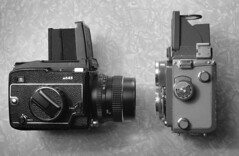Difference between revisions of "Reflex"
(created) |
(Added photo of reflex cameras) |
||
| (6 intermediate revisions by 3 users not shown) | |||
| Line 1: | Line 1: | ||
{{Glossary}} | {{Glossary}} | ||
| − | The term '''Reflex''' | + | {{Flickr_image |
| + | |image_source= http://www.flickr.com/photos/camerawiki/5504570061/in/pool-camerawiki | ||
| + | |image= http://farm6.static.flickr.com/5213/5504570061_9b4438f81e_m.jpg | ||
| + | |image_align= right | ||
| + | |image_text= Reflex cameras: single lens and twin lens | ||
| + | |image_by= Voxphoto | ||
| + | |image_rights= non-commercial | ||
| + | }} | ||
| + | The term '''Reflex''' is used as a way of classifying types of cameras, based on their [[viewfinder|viewfinder system]]. | ||
| + | |||
| + | Many cameras view the scene using a straight-through optical viewfinder, an open frame, or a [[brilliant finder]]. A [[reflex finder]] is distinguished by using a mirror, either behind the taking lens ([[SLR|single-lens reflex - '''SLR''']]), or behind a second lens, similar to the taking lens ([[TLR|twin-lens reflex - '''TLR''']]). The mirror reflects the image onto a [[ground glass]] where focus and framing can be evaluated. | ||
| + | |||
| + | The earliest reflex cameras used waist-level viewing, where the photographer looks downwards into a hood (or, a magnifying lens) at the groundglass. A disadvantage of such reflex finders is that the image is laterally reversed, - making following a subject's movements difficult. Reflex finders offering eye-level viewing via a [[pentaprism]] avoid this problem. | ||
| + | |||
| + | The advantage of using a reflex viewfinder is that a better impression of the framing, focus and [[depth-of-field]] can be gained. With an [[SLR]], using the taking lens, the framing and depth-of-field can be viewed directly, although most SLRs have a view slightly smaller than the full frame. Another disadvantage is the added bulk and weight of the mirror system, and either extra lens or mirror movement mechanism, and in an SLR, the delay, noise and [[mirror slap|vibration]] caused by moving the mirror. | ||
| + | |||
| + | ''See also: [[reflex finder]]''. | ||
| + | |||
| + | [[Category: Camera architecture]] | ||
Latest revision as of 05:09, 7 March 2011

|
| Reflex cameras: single lens and twin lens image by Voxphoto (Image rights) |
The term Reflex is used as a way of classifying types of cameras, based on their viewfinder system.
Many cameras view the scene using a straight-through optical viewfinder, an open frame, or a brilliant finder. A reflex finder is distinguished by using a mirror, either behind the taking lens (single-lens reflex - SLR), or behind a second lens, similar to the taking lens (twin-lens reflex - TLR). The mirror reflects the image onto a ground glass where focus and framing can be evaluated.
The earliest reflex cameras used waist-level viewing, where the photographer looks downwards into a hood (or, a magnifying lens) at the groundglass. A disadvantage of such reflex finders is that the image is laterally reversed, - making following a subject's movements difficult. Reflex finders offering eye-level viewing via a pentaprism avoid this problem.
The advantage of using a reflex viewfinder is that a better impression of the framing, focus and depth-of-field can be gained. With an SLR, using the taking lens, the framing and depth-of-field can be viewed directly, although most SLRs have a view slightly smaller than the full frame. Another disadvantage is the added bulk and weight of the mirror system, and either extra lens or mirror movement mechanism, and in an SLR, the delay, noise and vibration caused by moving the mirror.
See also: reflex finder.